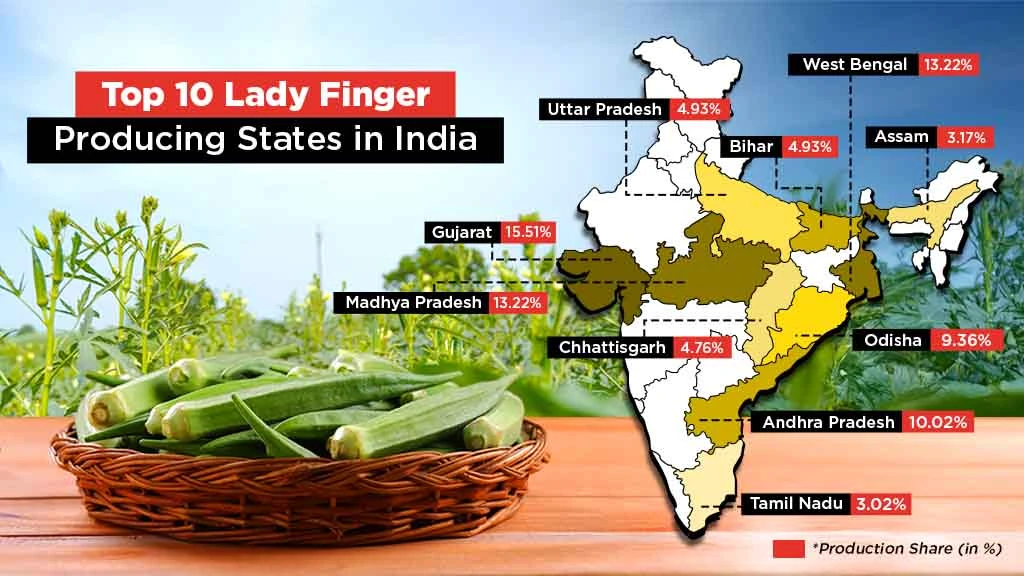Lady Finger Cultivation in India: Varieties, Production & Step-by-step Cultivation Process

Lady finger, also known as Okra and Bhindi, is a popular Indian vegetable grown in tropical and subtropical parts of the world. India is one of the largest producers of lady fingers in the world. In this blog, we will discuss the lady finger plants, its varieties, production, and the complete cultivation process.
Table of Contents
- Overview of Lady Finger Plant
- Which are the Popular lady finger varieties in India?
- What is the step-by-step lady's finger cultivation process in India?
- Which are the top 10 Lady Finger Producing States in India?
Overview of Lady Finger Plant
Lady Finger, Okra or Bhindi, is a hairy annual erect herb that grows 0.9 to 2.1 m tall with 3 to 5 lobed palmately cordate leaves. It is a tropical and subtropical plant grown for its young, sensitive fruits, which are cooked and used in soups and curry. Lady fingers are rich in Vitamins A and B, proteins, and minerals. It is also considered an excellent source of iodine, which can help in the treatment of goitre. When the lady finger is not in season, its fruit is often dried and frozen for usage during the off-season. The immature lady finger fruits are commonly consumed as a vegetable. The dried seeds of lady finger can offer oil and protein. Mucilage from lady finger’s roots and stems is used for clarifying sugarcane juice in jaggery production. Its fully mature fruits and stems that contain crude fiber are widely used in the paper industry. Let’s discuss the popular lady finger varieties and their cultivation process.
Which are the Popular lady finger varieties in India?
The popular Lady finger varieties in India are:
- Pusa Makhmali
- Pusa Sawani
- Red Bhindi
- Selecion-2
- Vaishali Vadhu
- Panjab Padrnini
- Parbhani Kranti
- Varsh Uphar
- Arka Anamika
What is the step-by-step lady’s finger cultivation process in India?
The lady finger farming involves several steps, including soil & climate requirements, land preparation, sowing & plantation, manure and fertilizers, irrigation, intercultural operations, plant protection measures, and harvesting and yield. Let’s discuss each of them in detail:
Soil & Climate Requirements
Lady finger can be grown in all types of soil, but the soil should be friable. However, light soils ranging from sandy loam to loam are best suited for lady finger cultivation. It can also tolerate slightly acidic soil. Lady finger plant is a tropical and subtropical crop that requires a long, warm and humid growing season. Okra is susceptible to frost, and it does not thrive well during the winter season. The ideal temperature for the seed germination of lady finger plant is 29°C.
Land Preparation
The land should be well prepared with 2 to 3 ploughings. A well-decomposed FYM (25 t/ha) should be incorporated at the time of land preparation. Using organic matter, such as neem cake and poultry manure, boosts crop development and productivity.
Sowing & Plantation
The sowing time for summer season crops is from mid of February to mid of March. For rainy season crops, it is from mid of May to mid of June and in hilly areas, the sowing time is March to May. The seed rate for spring-summer and winter season crops is 15 to 20 kg per hectare, whereas the seed rate for the rainy season crop is 8 to 10 kg per hectare. Lady finger plant is sown in rows using the dibbling method. It can also be sown by dropping the seeds behind the plough furrow. During the rainy season, the seeds should be sown on ridges. The spacing should be 30 X 45 cm for spring-summer crops, and 45 X 60 cm for rainy season crops.
Manure and Fertilizers
The amount of fertilizer applied during lady finger farming is decided by the amount of organic manure added to the crop and soil fertility. During the time of land preparation, around 20 to 25 tonnes per hectare of Farm-Yard-Manure is mixed in the soil. Generally, it is recommended to add 100 kg N, 60 kg P2O5, and 50 kg K2O for maximum yield. A half-dose of N, and full dose of P2O5 and K2O are applied during plantation time. The remaining half of N should be applied 30 days after sowing, followed by the earthing-up method, which involves digging a deep furrow on one side of each sowing ridge and loading it with fertilizer.
Irrigation
Irrigation frequency in lady finger cultivation varies with the season and soil type. The first irrigation should be given just after sowing. For spring-summer crops, subsequent irrigation should be provided at an interval of 5 to 8 days, whereas for winter season crops, irrigation should be provided at an interval of 10 to 12 days. In case of rainy season crops, no irrigation is needed.
Intercultural Operations
The crops should be weed-free during the first 20 to 25 days of plant growth. Weeding should be done 3 to 4 times. The first weeding should be done when the seedlings are 2 weeks old, and the remaining 2 to 3 weedings are done at a 25-day interval.
Plant Protection Measures
Lady finger plants are prone to different pests and diseases.
- Pests: Some pests, like jassids and shoot and fruit borer, can affect the growth. Jassids can be controlled by spraying Malathion 0.05% 15 days after germination, followed by Dimethoate 0.03% 25 to 30 days after germination. Shoot and fruit borer can be controlled by applying Endosulfan 0.06% followed by Neem seed kernel extract 5% mixing it with Endosulfan 0.045%.
- Diseases: Some diseases, like Fusarium wilt and yellow vein mosaic, are common in lady fingers. Fusarium wilt can be prevented by following crop rotation and removing all the affected plants. Deep summer ploughing is also effective in this case, and seeds should be treated with Ziram 0.3% for 30 minutes. Yellow vein mosaic can be controlled by spraying Dimethoate 0.03% after 15 and 30 days of germination. Additionally, uprooting and destroying the affected plants can also be done to prevent them.
Harvesting and Yield
Lady finger fruits are ready for harvest in around 45 to 60 days after seed sowing, based on season and variety. The pod size and stage at which it is harvested vary with variety and market preference. Usually, medium-sized tender pods (7-10 cm long) are harvested as they can be snapped from the plants easily. Since not all the fruits mature at the same time, harvesting should be done once every 3 to 4 days. The yield of lady finger varies based on variety and season of cultivation. The average lady finger yield per acre is around 3.04 to 4.05 tons.
Which are the top 10 Lady Finger Producing States in India?

As per the data published by APEDA, the lady finger production in India in 2023-24 was around 7305.43 thousand tons. Gujarat is the largest producer of Lady finger in India, followed by Madhya Pradesh, West Bengal, Bihar, and Andhra Pradesh. The top 10 lady finger-producing states in India are listed in the table below:
|
State |
Production (thousand tons) |
Percentage Share |
|
Gujarat |
1,133.08 |
15.51 |
|
Madhya Pradesh |
965.48 |
13.22 |
|
West Bengal |
954.95 |
13.07 |
|
Bihar |
810.70 |
11.10 |
|
Andhra Pradesh |
732.35 |
10.02 |
|
Odisha |
863.73 |
9.36 |
|
Uttar Pradesh |
360.09 |
4.93 |
|
Chhattisgarh |
347.67 |
4.76 |
|
Assam |
231.55 |
3.17 |
|
Tamil Nadu |
220.51 |
3.02 |
Frequently Asked Questions On Lady Finger Cultivation in India
1. How long does it take to grow a lady finger?
A lady finger plant is ready for harvest in around 45 to 60 days after sowing.
2. What is the season for lady finger crops?
Lady finger crops require a long, warm and humid season for better growth.
3. What is the best month to grow okra?
The best month for growing okra is from mid-February to mid-June.
4. How many times can you harvest okra?
Okra can be harvested multiple times from the same plant as it is a cut-and-come-again crop.
5. What is the fruiting period of okra?
The fruiting period of okra is around 45 to 60 days.
6. What should okra not be planted next to?
Okra should not be planted next to many crops, such as squash, sweet potatoes, tomatoes, peppers, etc.
7. What is the best fertilizer for okra?
FYM, N, P2O5, and K2O are the best fertilizer for okra.
8. How many okra seeds should I plant in one hole?
Around 2 to 3 okra seeds should be planted in one hole.


Related Blogs












